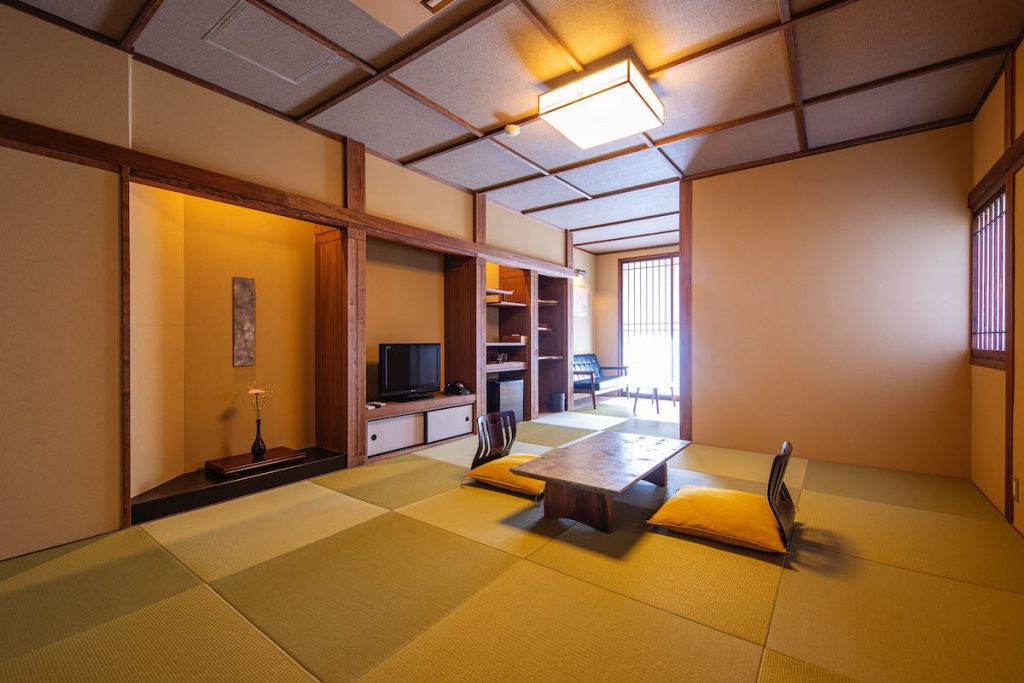
Overview :
Kashiwaya Ryokan offers various kinds of rooms. Japanese style rooms, Washitsu, are explained at the end of this article, featuring Tatami mats, Shoji sliding doors, Tokonoma alcoves, and Futon beds. These terms are explained in detail below.
Text :
Shima Onsen Kashiwaya Ryokan underwent a large-scale renovation in March 2021.
Therefore, we would like to introduce the available rooms and their new appearance.
In addition, we will introduce the furnishings of Japanese-style houses and inns such as Tatami, Shoji, Fusuma, Tokonoma, and Futon.
Please refer to it for your next trip to Japan.
Shima Onsen Kashiwaya Ryokan is a small and cosy Japanese hot spring inn welcoming you with fourteen rooms of nine different types.
We provide our guests with Japanese-style Futons, western-style beds, and rooms for solo travellers. They are equipped with Tatami mats, Japanese-style Tokonoma alcoves, and Shoji sliding doors and Fusuma with paper on wooden frames. You can immerse yourself in Japanese culture here.
Table of contents :
Room type 1. A guest room with an open-air bath, named Kame (Introduced in another article)
Room type 2. A guest room with an open-air bath, named Hana (Introduced in another article)
Room type 3. A Japanese-style room with a footbath on an open-air terrace
Room type 4, 5. Standard Japanese-style room with a terrace (first and second floors)
Room type 6. Twin room with a deck terrace
Room type 7. Twin room
Room type 8, 9. Two single rooms, named Niji and Akari
About the facilities of the Japanese-style rooms: Tatami, Shoji, Fusuma, Tokonoma, and Futon
Hikari – Japanese-style room the size of ten Tatami mats with a footbath terrace
A newly-renovated room with a footbath on the deck terrace has made an appearance.
It is a Japanese-style room called Hikari (meaning “Sunlight”) with a footbath terrace.
It has a footbath where two people can sit side by side on the terrace with a spacious Japanese-style room with ten Tatami mats and a veranda.
While you soak your feet and relax in the footbath, you can feast your eyes on the streams and mountains surrounding Shima Onsen. The scenery varies with the seasons and times.
You can see a stunning panoramic view from your room in the fresh spring season.
The autumn leaves and snowy landscape are also spectacular and worth viewing.
This room is a spacious enough for a large number of people, so families and groups can comfortably stay together.
Book the Hikari – Japanese style room with a footbath
Standard – Japanese-style room the size of eight Tatami mats with a deck terrace
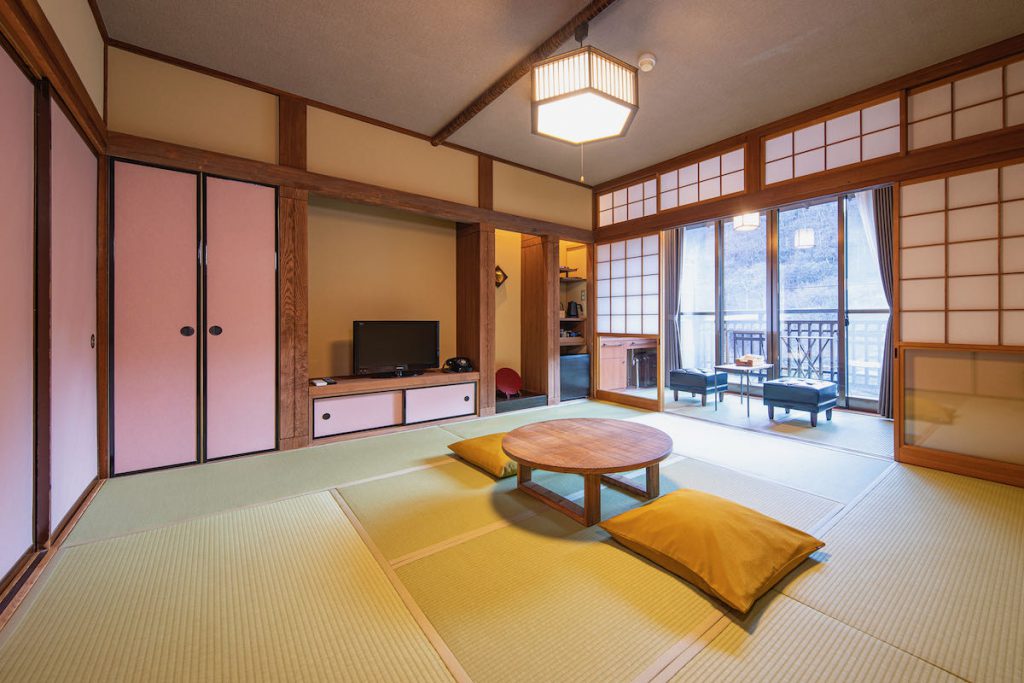
This is our standard Japanese-style room. There are three rooms on the second floor and one room on the first floor.
These rooms are Matsu (“pine tree”), Take (“bamboo”) ,Ume (“plum”) on the second floor and Hoshi (“star”) on the first floor.
They are the size of eight Tatami mats each, just the right size, and feature a veranda. They all have a terrace from which you can overlook the streams and mountains around Shima Onsen.
These rooms have a Japanese-style low dining table made by local craftsmen.
They hold the charming atmosphere of a classic Japanese room such as with Tatami mats, Shoji screens, Tokonoma alcoves, Fusuma sliding doors, and Futons, just like the Japanese-style room with a foot-bath terrace (named Hikari).
Book the standard Japanese style room (2F)
Book the standard Japanese style room (1F)
The twin room with a deck terrace
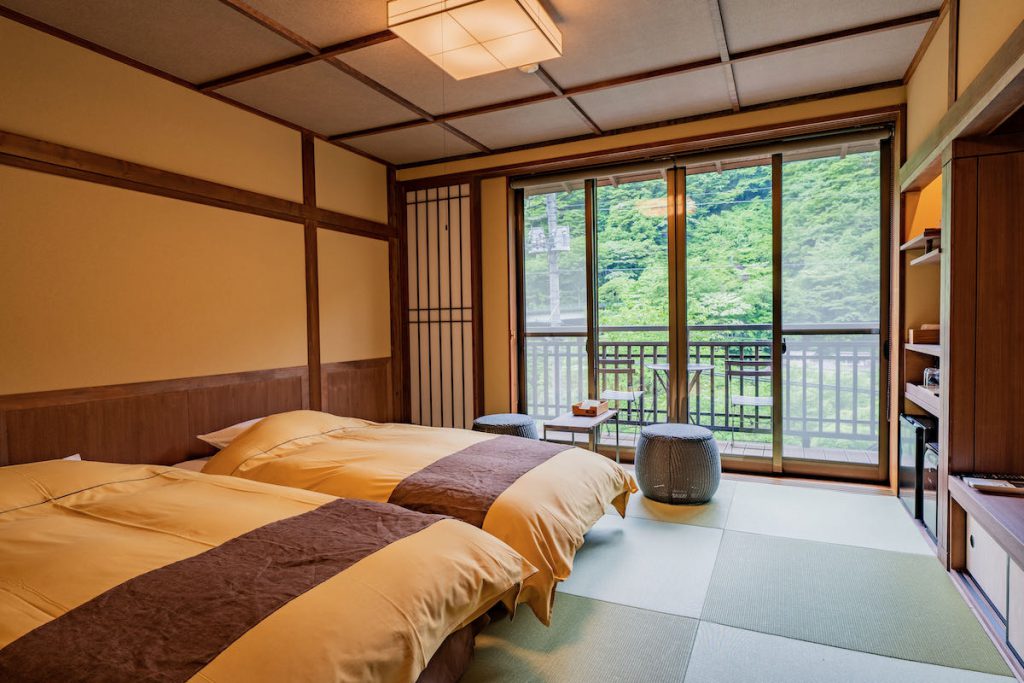
This room has two single beds in a Tatami mat room the same size as a Japanese-style eight Tatami mat room with a deck terrace. Western-style beds are provided in this room and offer something of a western air, yet with a Japanese atmosphere, so you can completely immerse yourself in the atmosphere of the Japanese room.
There are three rooms in total, and all of them are located near the private open-air bath.
These rooms are Tsuki (“moon”), Akatsuki (“dawn light”) and Youhi (“sunset”)
The renovation work in 2021 expanded the toilets and washroom to make your stay more pleasant and comfortable.
There are three rooms in total, and all of them are located near the private open-air bath.
The twin room
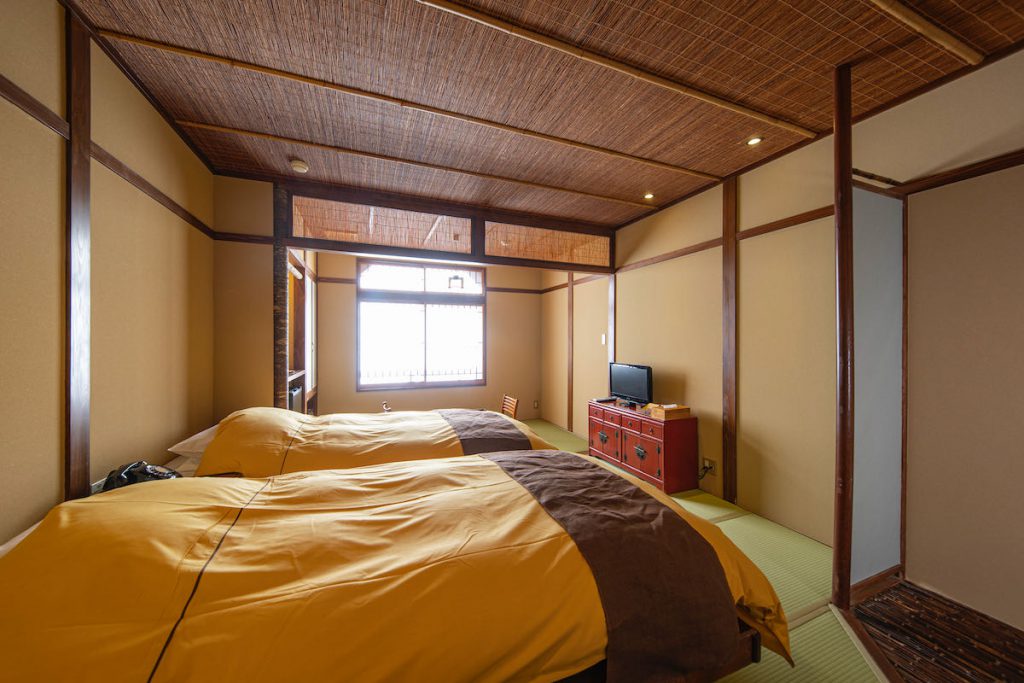
This room has two single beds in a Tatami mat room. This compact yet relaxing room was designed by the leading architect for Japanese style inns. It is the most popular, attracting repeat customers. Solo travellers are also welcome to stay here.
Two single rooms, Niji and Akari
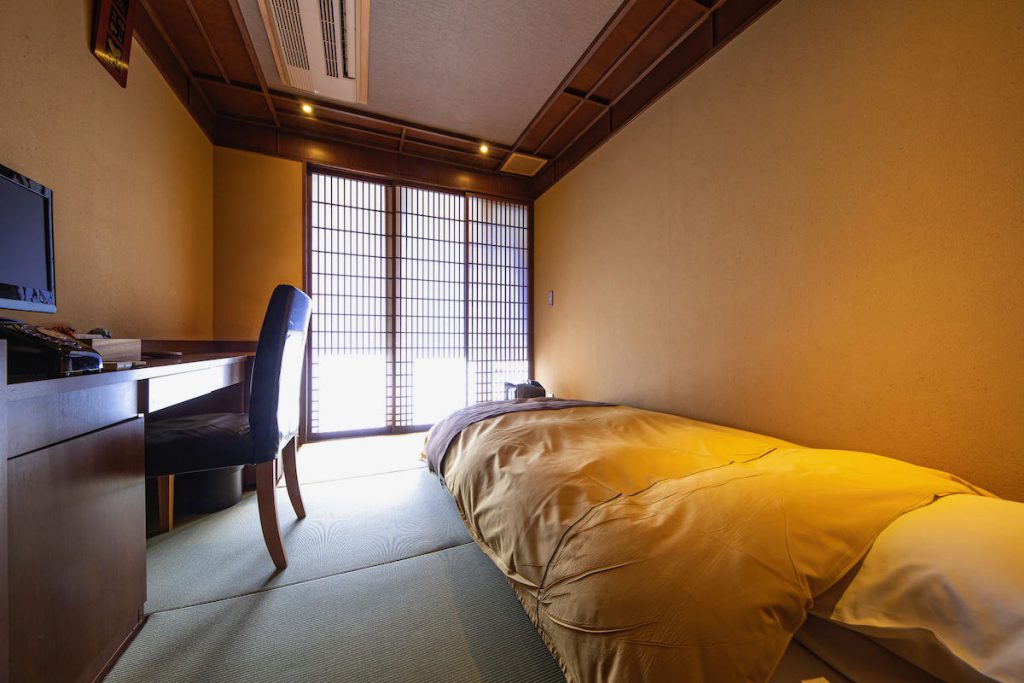
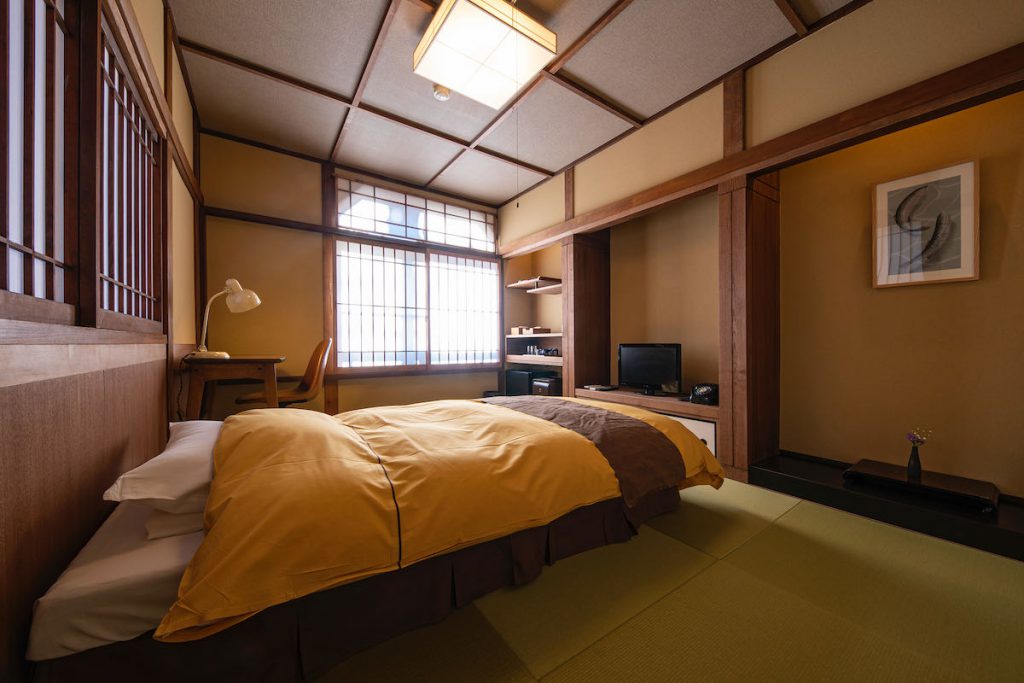
All kinds of solo travellers are welcome at Shima Onsen Kashiwaya Ryokan.
Previously, there was only one room, the single room (Akari, meaning light) with a deck terrace on the first floor, available for solo travellers on Saturdays and holidays such as New Year holiday and Golden Week holiday.
We have added another room in the renovation project so visitors can stay all year round.
There is also a single room (Niji, meaning rainbow) on the second floor.
This is the only room (Japanese-style, the size of six Tatami mats) that hadn’t changed its floor plan since it first opened in 1976. It has a new look after being fully renovated as a room exclusively for solo travellers.
The single room (Akari) on the first floor is popular for solo travellers. The room has a large deck terrace and is also the right next to the Yuagari Library, where you can get free drinks. Another good thing to note is that it is close to the large communal baths for men and women, which are often less crowded than most public baths.
Book the single room Niji (2F)
Book the single room Akari (1F)
The unique words expressing the Japanese rooms , such as Tatami, Shoji, Fusuma, Tokonoma, and Futon.
I introduced some unique words expressing the Japanese rooms in this article, such as Tatami, Shoji, Fusuma, Tokonoma, and Futon.
We will discuss the meaning of these words below.
Tatami
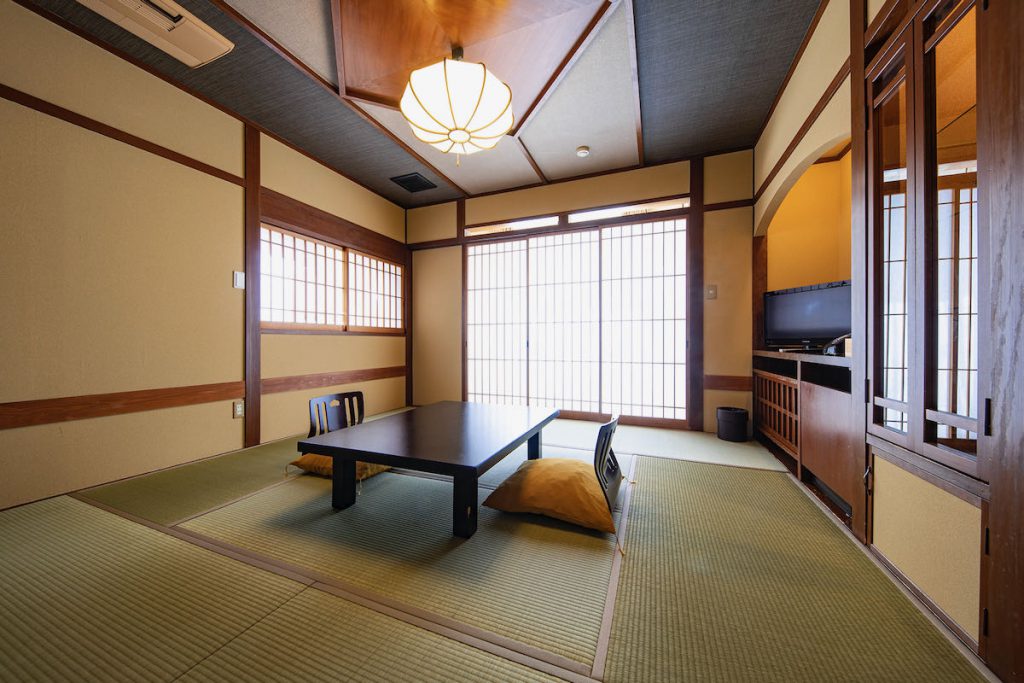
The Tatami mat is somewhat light and is spread on the floor of Japanese-style rooms without any gaps.
Traditional Tatami mats are made from soft rush woven in a core of rice straw.
Nowadays, cores with improved heat insulation and Tatami mats with improved durability are more commonly used.
Most Tatami mats are rectangular in shape, and each mat is around 1.8m x 0.9m (5.9 feet x 2.95 feet). To be more specific, there are several standard sizes such as Kyoma (large), Chukyoma (medium), and Kantoma (small).
To measure the size of a room, you count the number of Tatami mats as a unit of space; how many Tatami mats are used in the room. Because there are different Tatami sizes depending on their standards, for example, rooms the size of eight Tatami mats are not always the same size.
In Shima Onsen Kashiwaya Ryokan, there are rooms with standard-sized Tatami mats laid out on the floor and Tatami mats halved vertically to make them square shapes. We call this a Ichimatsu-jiki (laying like a checkered pattern).
Shoji
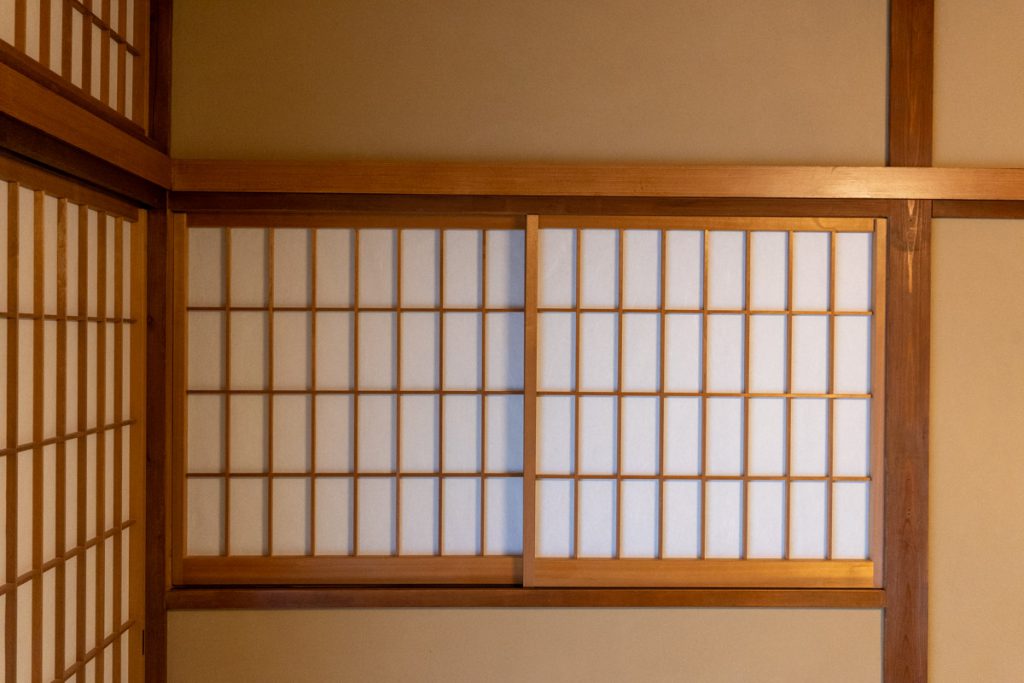
A Shoji is a sliding door used to divide rooms. It consists of a rectangular wooden frame and Japanese washi paper.
It was originally named for its feature of “shielding” or “blocking.” It refers to a wooden frame with Japanese paper pasted on it.
At Kashiwaya Ryokan, Shoji are installed in front of glass windows to separate master rooms and their verandas. Our Japanese-style room with a deck terrace, eight Tatami mats (second floor), has a Yukimi Shoji, where the lower half is made of glass.
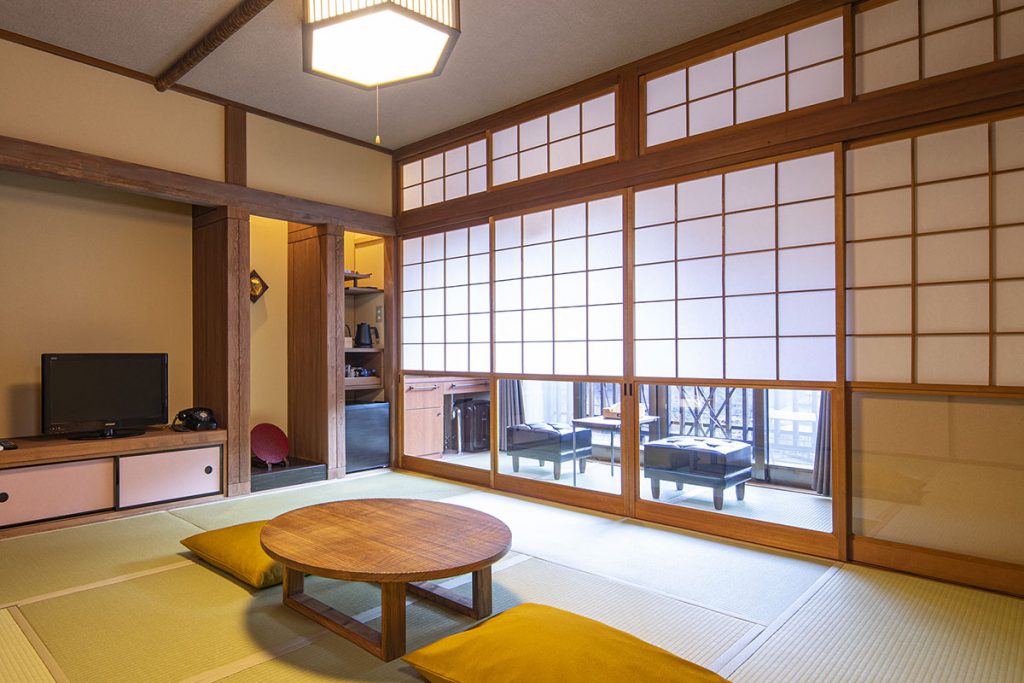
The Japanese paper allows forty to fifty percent of light transmission compared to glass. It blocks direct sunlight softly and lightly, letting in a relaxing, dim light.
Fusuma
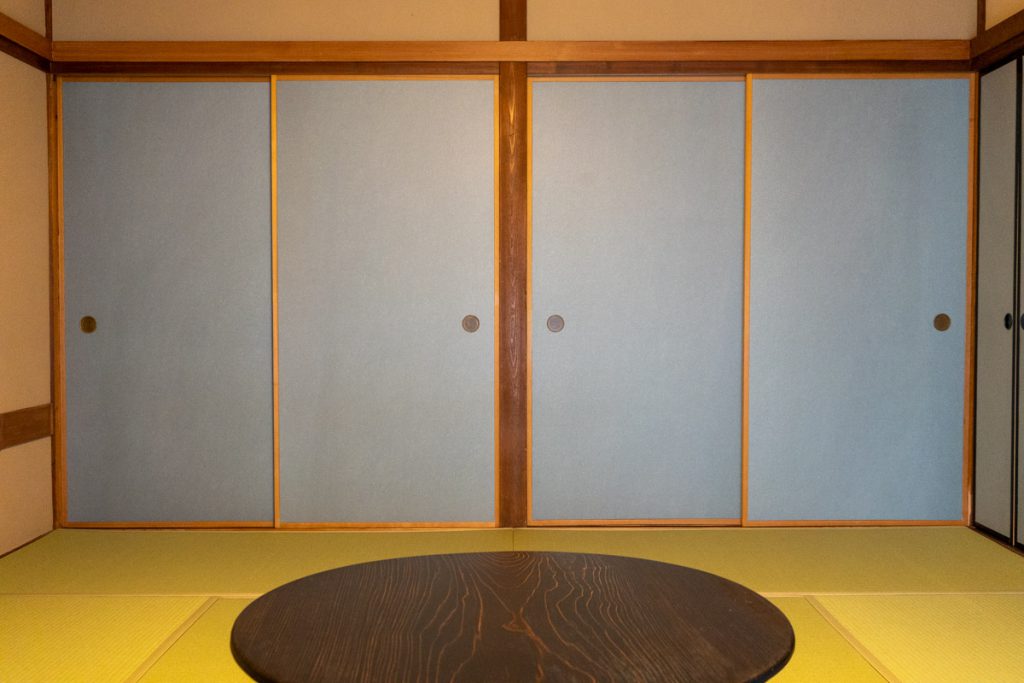
Like Shoji, sliding doors, called Fusuma, divide rooms. The difference is that they block light completely. They are used at the entrance to the main room and for closet doors.
You can make more space and create one large room that is usually separated by removing the sliding doors that usually separate the rooms.
It uses thick Fusuma paper that does not allow light to pass through at all, which is different from Shoji.
It has a handle, or a Hikite (meaning pull slider).
There are various kinds of designs of Fusuma. It can also be enhanced in status with various paintings on the Hikite. These can be crafted using gold, silver, copper, iron, brass, etc.
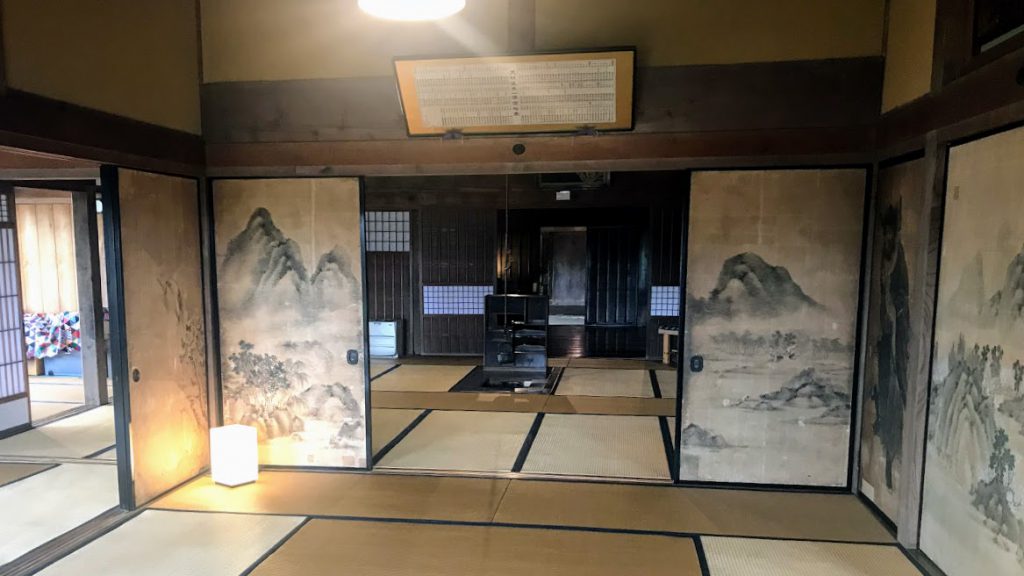
The paper of the sliding doors in Kashiwaya Ryokan is made in different colours, reflecting the image of the four seasons of Japan.
Tokonoma
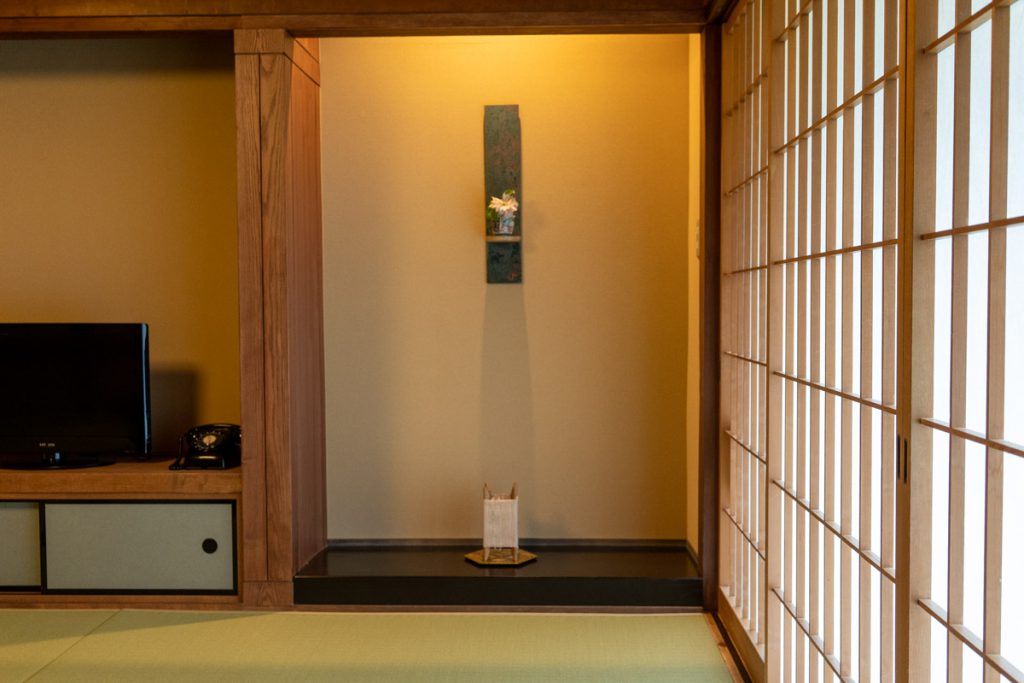
This is a decoration space, a sacred space, in the guest room where ornaments such as Japanese scrolls are displayed.
Its floor is generally raised ten centimetres above the Tatami floor.
It is considered bad manners if you sit in the alcove or step on it.
A Tokonoma alcove in a Japanese-style room is considered a space of honour. It is a place where you can sit with your back facing the alcove, so please keep this in mind.
In Kashiwaya Ryokan, Tokonoma alcoves are somewhat simplified, but great alcoves are set up in most of the rooms displaying sculptures made by artists, flower arrangement, paintings and so on.
Futon
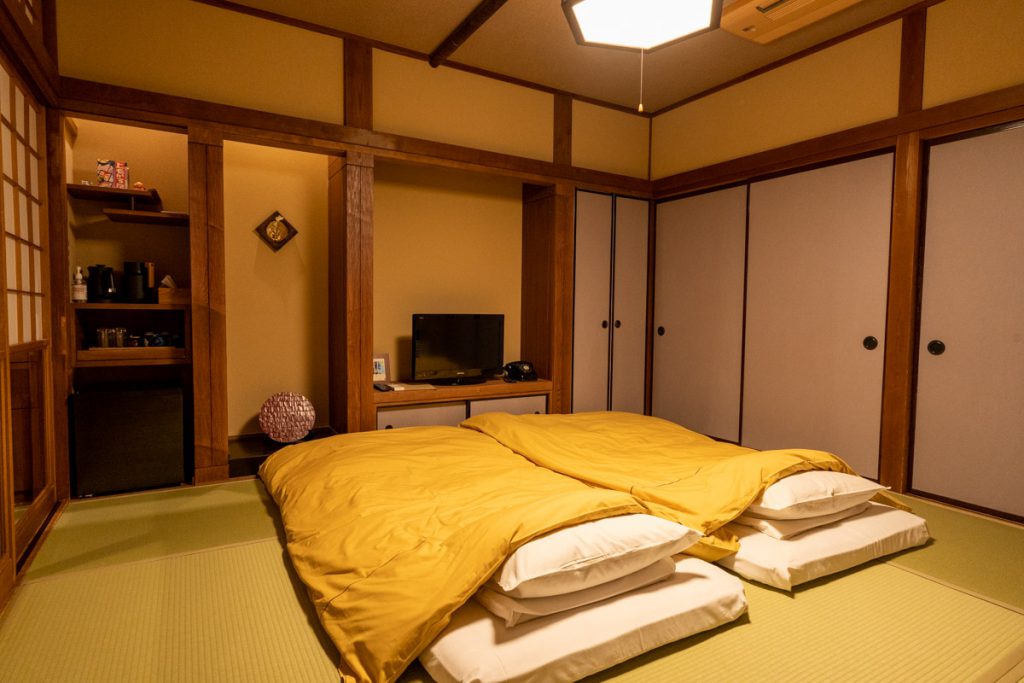
Kashiwaya Ryokan also has Tatami rooms with western-style beds, but many of the Japanese-style Tatami rooms feature Futon beds.
The biggest difference between Japanese Futons and western-style beds is that you can fold and store them in the closet during the daytime. It serves as a space-saver to make more space in the room.
I’ve heard that people who stayed in a Japanese-style inn were surprised to see the Futon was set up when they returned to their rooms after their evening meal. Because when they checked in and first entered the room, there was no Futon set. I wonder how they felt?
There are other more difficult technical terms such as Nagashi, Kamoi, Shikii, Ranma, And Hiroen for the Japanese-style rooms. They will be explained another time, so please look forward to it!
Have a pleasant stay in Japanese wooden architecture with a long history and tradition, just as well preserved as Horyuji Temple in Nara, the oldest wooden building in the world, built over 1,400 years ago !
If you interested in Japanese style Onsen, Please click here
Shima Onsen Kashiwaya Ryokan >

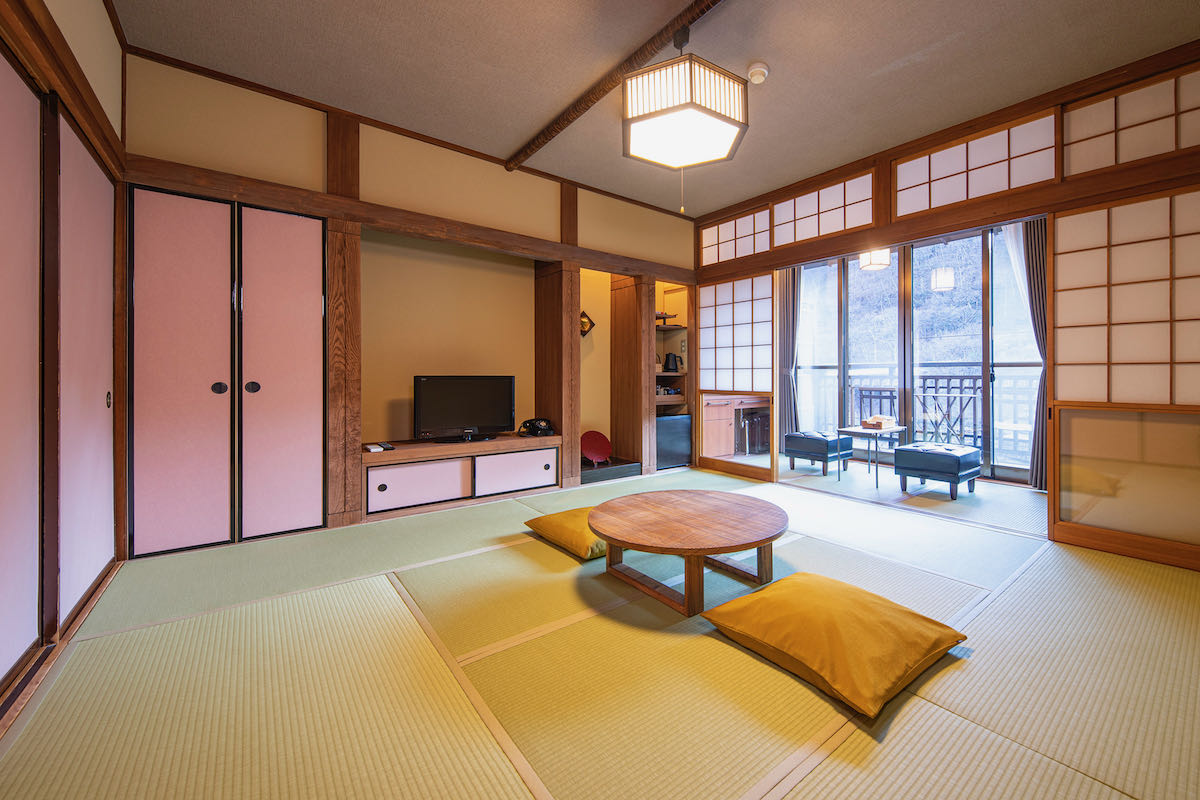
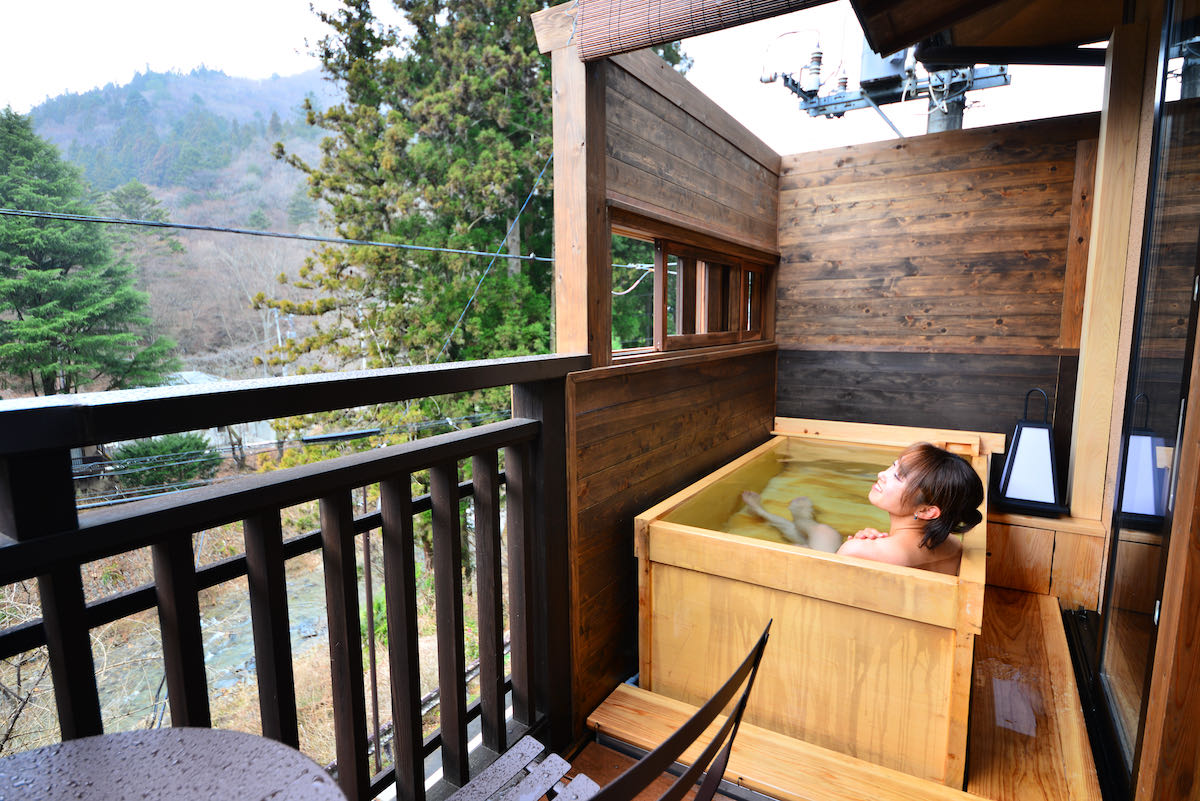

Comments